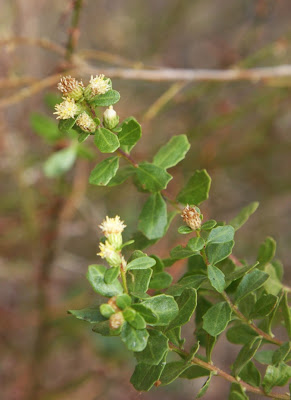Coyote brush, Baccharis pilularis, is dioecious - it has male and female plants. Male plants have staminate flowers, with pollen, and female plants have pistillate flowers, which, when pollinated, develop into seeds with a lot of fluff.
Tidy gardeners don't like the fluff, and the plants you buy in the nurseries are all male.
But if you want to support wildlife with the seeds, or do restoration, i.e., have a self-stustaining population, or if you just enjoy the fluff - then you'll have to get your female plants from somewhere else, like a restoration nursery. Or you can collect seeds from a friendly property owner who has wild ones growing. They germinate easily so you won't need a lot.
Or, if you want to propagate male plants from wild plants, you need to watch for the male flowers and take cuttings from that plant.
To the best of my knowledge, you can't tell the plants apart until they flower. Flowering occurs June, July, and August roughly. So here is a quick pictorial. These flowers are small and it can be a bit hard to tell the difference when they are young.
Actually now that I look this up in Jepson -- I'm learning that each "flower" is actually a head of many tiny flowers -- Baccharis pilularis is in the sunflower family, Asteraceae.
The Girls
The female (pistillate) flowers are creamy white and quickly grow to resemble little artists' paint brushes.
 |
| A bush of female flowers, going to seed. |
 |
| Female flowers again - a little older than the photo above. I'm not a botanist - but I think they have been pollinated at this point. |
The boys
The male (staminate) flowers have an overall yellowish tinge and they grow brown when they are done. The name origin is as follows:
However I think "pill-shaped" describes only the male flowers which have a flatter top.
The genus name Baccharis refers to the Roman god Bacchus, a god of vegetation and of wine; pilularis, meaning “pill-shaped,” refers to the round, flat flower heads.(Source: http://www.wildflower.org/plants/result.php?id_plant=BAPI)
However I think "pill-shaped" describes only the male flowers which have a flatter top.
 |
| Male flowers have a yellowish to brownish tinge. They brown when older. |
 |
| Male flowers' corollas (and maybe anthers) are yellowish. The male flowers are stubbier than the female flowers. "Pill" shaped - as indicated in the name "pilularis" |
 |
| Male flowers turning brown |
Also if you just want to show off to your hiking buddies, now you can tell them the difference between male and female coyote brush flowers!


Comments
Also wish I'd have put the origin of the name as it helps to remember the shape of the male flower: The genus name Baccharis refers to the Roman god Bacchus, a god of vegetation and of wine; pilularis, meaning “pill-shaped,” refers to the round, flat flower heads." (from http://www.wildflower.org/plants/result.php?id_plant=BAPI)